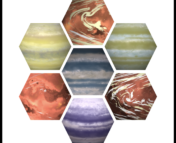Title: A Circumplanetary Dust Ring May Explain the Extreme Spectral Slope of the 10 Myr Young Exoplanet K2-33b
Authors: Kazumasa Ohno, Pa Chia Thao, Andrew W. Mann, Jonathan J. Fortney
First Author’s Institution: Department of Astronomy & Astrophysics, University of California, Santa Cruz, USA
Status: Published in ApJ Letters (open access)
Interpreting the transmission spectra we observe from exoplanet atmospheres can be really tricky. While many of the features we see occur at characteristic wavelengths, the exact shapes and sizes of these features are controlled by a host of different factors, leaving a complex web of chemistry to untangle. For example, take what’s often known as the “scattering slope” – a rise in the spectrum of an atmosphere towards bluer wavelengths. At these wavelengths, less light passes through the planet’s atmosphere, causing the depth of its transit at those wavelengths to appear deeper, as shown in Figure 1. This slope gets its name because it can be caused by the presence of clouds and hazes scattering light in the atmosphere, and how steep it is can provide information about such hazes. However, very steep slopes can also be caused by active regions on the host star’s surface, since transmission spectroscopy requires looking at the star’s light as it passes through the planet’s atmosphere.

K2-33b is one such planet with a very steep slope (check out this astrobite to find out more!), with ground- and space-based observations showing much deeper transits at bluer wavelengths, as seen in Figure 1. In this case, the host star probably isn’t active enough to be inducing the slope seen, so a hazy atmosphere around a puffy, low-density planet is thought to be the culprit. But what if there was another possible explanation? The authors of today’s paper consider whether a ring of dust around K2-33b could be responsible.
Ringing Out the Details
Using the presence of exoplanetary rings to understand seemingly unexplainable observations isn’t a new idea. Rings could explain why some very low-density exoplanets have very flat transmission spectra, since the presence of rings would increase the radius obtained from the transit method, but wouldn’t significantly increase the mass of the system. But if rings produce a flat spectrum, how could they explain what’s happening with K2-33b? The authors of today’s paper explain that the opacity of the ring is essential (take a look at Figure 2 for a handy guide!).

Too optically thick, as shown on the left-hand side of Figure 2, and the ring blocks light at optical wavelengths, producing a flat transmission spectrum. Too optically thin, as shown on the right-hand side of Figure 2, and the ring doesn’t interact with the star’s light at all, having no impact on the transmission spectrum. But, as shown in the middle of Figure 2, if the ring’s opacity is just right, the star’s light passing through the ring will be absorbed more at bluer wavelengths. This creates a steep slope in the optical part of the transmission spectrum, similar to one that might be created by scattering from a hazy atmosphere. Crucially, a ring-induced slope can be much steeper than might be produced by the atmosphere alone.
Does the right ring make a good match?
To check whether this explanation could work for the transmission spectrum of K2-33b, the authors model both the atmosphere of the planet and rings of different mineral compositions.

Figure 3 demonstrates that with the right opacity, rings of all compositions are able to match the observations, reproducing the steep slope caused by the deeper transits at blue wavelengths. By comparing the coloured models to a model without the presence of a ring, shown by the grey line in each panel, it’s clear that the addition of rings is a big improvement! Many of the ring compositions also produce distinctive absorption features in the mid-infrared, which, if present, would be easily identified with JWST’s MIRI instrument and would help confirm the existence of a ring.
If the ring models provide a good match, does this mean K2-33b has a ring? Maybe! Since extremely low-density planets are expected to struggle to hold onto their atmospheres, and the ring scenario results in a higher-density planet than the hazy alternative, rings might start to seem like the more favourable option. But, sustaining a dusty ring for long periods of time is also tricky. While mid-infrared observations will be helpful for understanding whether a ring is really present or not, until JWST points its hexagons at K2-33b, both scenarios remain perfectly reasonable.
Astrobite edited by Jessie Thwaites
Featured image credit: NASA/Cassini/James O’Donoghue




